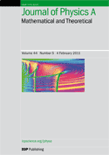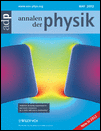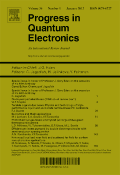
AVS Quantum Science
Scope & Guideline
Fostering Collaboration in Quantum Discovery
Introduction
Aims and Scopes
- Quantum Computing and Algorithms:
The journal publishes research on quantum algorithms, including their development and application in solving complex mathematical problems and simulating physical systems. - Quantum Sensing and Metrology:
Research in this area focuses on the development of advanced quantum sensors and measurement techniques, enhancing precision and accuracy in various applications, including gravitational wave detection and dark matter searches. - Quantum Information Theory:
This encompasses studies on quantum communication, entanglement, and network protocols, aiming to improve the efficiency and security of quantum information transfer. - Quantum Materials and Devices:
The journal covers research on novel quantum materials and their applications in devices, emphasizing the interaction between quantum mechanics and material properties. - Quantum Thermodynamics and Control:
Studies in this scope explore the thermodynamic behavior of quantum systems, including energy transfer, quantum heat engines, and optimal control strategies. - Quantum Optics and Photonics:
This area includes research on light-matter interactions, photon manipulation, and the development of photonic technologies for various applications.
Trending and Emerging
- Machine Learning in Quantum Systems:
There is a growing trend in applying machine learning techniques to optimize quantum algorithms and enhance quantum state characterization, indicating a cross-disciplinary approach that combines quantum science with artificial intelligence. - Quantum Networks and Communication:
Research focusing on the development and optimization of quantum networks, including entanglement distribution and quantum repeaters, has gained momentum as the quest for a scalable quantum internet evolves. - Hybrid Quantum Systems:
The integration of different quantum systems, such as combining superconducting qubits with optical elements, is emerging as a prominent area of research, aiming to leverage the strengths of various platforms. - Quantum Thermodynamics:
The exploration of quantum systems under thermodynamic constraints is increasingly relevant, with implications for energy efficiency in quantum computing and the development of quantum thermal machines. - Quantum Metrology with Enhanced Sensitivity:
Recent studies emphasize the use of entangled states and squeezed light to improve measurement precision, particularly in gravitational wave detection and other sensitive applications.
Declining or Waning
- Classical Quantum Comparisons:
Research comparing classical and quantum methodologies, such as classical models of quantum phenomena, has seen reduced focus as the field matures and the distinct advantages of quantum approaches become clearer. - Foundational Quantum Theory:
Papers exploring the philosophical implications or foundational aspects of quantum mechanics have diminished as the community shifts toward more application-oriented studies and experimental validations. - Quantum Gravity Studies:
Although still relevant, the specific investigations into quantum gravity and its implications for quantum mechanics have decreased, perhaps due to the complexities and the need for more experimental support.
Similar Journals

Journal of Physics A-Mathematical and Theoretical
Exploring Dynamic Models in the Realm of Theoretical PhysicsThe Journal of Physics A-Mathematical and Theoretical, published by IOP Publishing Ltd, is a premier peer-reviewed journal dedicated to advancing the understanding of mathematical physics, modeling, and simulation methods within the dynamic field of physics and astronomy. Established in the United Kingdom, this journal has made significant contributions over the years, maintaining a strong reputation as a Q1 and Q2 ranked journal across various categories, reflecting its influence in the scientific community. With a focus on innovative and theoretical approaches, it provides a platform for researchers, professionals, and students to disseminate their findings and engage with groundbreaking methodologies. Despite its lack of open access options, the journal's high impact factor and Scopus rankings, which place it in the top percentiles across multiple disciplines, underscore its critical role in fostering scholarly communication and collaboration in mathematical and theoretical physics. As we move through its converged years from 2007 to 2024, the Journal of Physics A continues to be a pivotal contributor to the landscape of contemporary physics, stimulating discussions and advancing knowledge in an ever-evolving realm.

npj Quantum Information
Fostering collaboration in the realm of quantum science.npj Quantum Information is a premier open-access journal published by NATURE PORTFOLIO, focusing on advancing the interdisciplinary field of quantum information science. First launched in 2015, the journal has rapidly established itself as a leading platform for innovative research, reflected in its impressive Q1 category rankings across multiple fields, including Computational Theory and Mathematics, Computer Networks and Communications, and Statistical and Nonlinear Physics. With an emphasis on publishing high-quality research, npj Quantum Information aims to disseminate pivotal findings that shape the future of quantum technologies and their applications. Its open-access model further enhances the accessibility of cutting-edge scholarly work, fostering collaboration and knowledge sharing among researchers, professionals, and students worldwide. With its commitment to excellence, the journal plays a crucial role in the intellectual landscape of quantum science, inviting contributions that push the boundaries of understanding and innovation.

Frontiers of Physics
Where Cutting-edge Research Meets Open AccessFrontiers of Physics, published by Higher Education Press, is a premier open-access journal dedicated to fostering innovative research and excellence within the field of physics. With an ISSN of 2095-0462 and an E-ISSN of 2095-0470, this rapidly growing journal has established itself as a valuable platform for disseminating cutting-edge findings, covering a diverse range of topics from theoretical frameworks to experimental advancements. Notably, Frontiers of Physics has achieved an impressive Q1 ranking in the 2023 Scopus Quartiles for Physics and Astronomy, securing a competitive 5th out of 81 positions in its category, reflecting a high impact factor that underscores its importance to the scientific community. Since its inception in 2011 and continuing through 2024, the journal aims to bridge the gap between academia and industry, encouraging collaboration among researchers, professionals, and students alike. Its commitment to open access ensures that high-quality research is readily accessible, thereby promoting knowledge sharing and advancement in the global physics community. Explore the potential of your research in Frontiers of Physics, where the future of physics flourishes.

ANNALEN DER PHYSIK
Connecting Scholars Through Groundbreaking ResearchANNALEN DER PHYSIK, a prestigious journal published by WILEY-V C H VERLAG GMBH, stands as a cornerstone of the field of physics and astronomy since its inception in 1799. With an ISSN of 0003-3804 and an E-ISSN of 1521-3889, this journal provides a platform for innovative research and critical discourse across various domains of physics. Annalen der Physik is currently ranked in the Q2 category for general physics and astronomy, occupying rank #76 out of 243 in Scopus, placing it within the 68th percentile. This indicates its significant impact and the quality of research it publishes. Although the journal does not offer Open Access options, its robust historical lineage and ongoing contributions ensure that it continues to be an essential resource for researchers, professionals, and students alike. For those seeking to stay at the forefront of contemporary physics research, ANNALEN DER PHYSIK represents a vital source of knowledge, innovation, and scholarly communication.

PRX Quantum
Fostering collaboration in the quantum landscape.PRX Quantum is a premier open-access journal published by the American Physical Society, dedicated to advancing the field of quantum studies. Launched in 2020, this journal serves as a vital platform for the dissemination of high-quality research across a diverse range of interconnected disciplines, including applied mathematics, computer science, and electronic engineering, as evidenced by its impressive rankings in the 2023 Scopus categories. With a remarkable impact factor and holding a top quartile position in multiple areas, PRX Quantum is not only pivotal for researchers engaged in quantum physics and related areas but also for professionals and students seeking to stay at the forefront of quantum technology and material science. Additionally, as an open-access journal, it champions the free distribution of knowledge, allowing for wider accessibility and engagement within the global research community. With a commitment to nurturing innovation and interdisciplinary collaboration, PRX Quantum is an indispensable resource for anyone interested in the evolving landscape of quantum science.

Physical Review Research
Unlocking the universe through open access research.Physical Review Research, published by the American Physical Society, is a premier open access journal dedicated to the dissemination of high-quality research across all areas of physics and astronomy. Since its inception in 2019, this journal has quickly established itself as a vital platform for researchers, achieving a prestigious Q1 ranking in the dynamics of Physics and Astronomy (miscellaneous) and holding a commendable position in the Scopus Rankings with a rank of #29 out of 243, placing it in the 88th percentile. With the commitment to fostering scientific collaboration and transparency, Physical Review Research offers unrestricted access to valuable findings, enabling researchers, professionals, and students alike to engage with cutting-edge contributions in general physics and astronomy. As it converges into its forthcoming years of publication, the journal remains dedicated to showcasing rigorous research and innovative ideas that drive the field forward.

PHYSICAL REVIEW LETTERS
Elevating Physics Knowledge with Every LetterPhysical Review Letters, published by the American Physical Society, is a premier journal in the field of Physics and Astronomy renowned for its rapid dissemination of high-impact research findings. With a distinguished history dating back to 1958 and an impressive ranking of #13 out of 243 in the general physics category, it stands proudly within the Q1 quartile, placing it in the top 6% of journals in its field. The journal focuses on brief reports of significant fundamental research across all areas of physics, making it an essential resource for researchers, professionals, and students seeking to stay at the forefront of developments in their field. Although Physical Review Letters does not offer open access options, its rigorous peer-review process ensures a high standard of quality and relevance in its published articles. With an unwavering commitment to advancing the understanding of physical science, this journal is indispensable for those looking to make a genuine impact in their research endeavors.

PROGRESS IN QUANTUM ELECTRONICS
Advancing Knowledge in Quantum TechnologiesPROGRESS IN QUANTUM ELECTRONICS, published by PERGAMON-ELSEVIER SCIENCE LTD, is a premier international journal that serves as a critical forum for the dissemination of high-quality research in the fields of atomic and molecular physics, electrical engineering, and materials science. With its esteemed Q1 category ranking in several disciplines, including Atomic and Molecular Physics, Electrical and Electronic Engineering, and Electronic, Optical and Magnetic Materials, this journal commands a high impact factor and is recognized for its rigorous peer-review process. Established in 1969 and evolving through various phases, the journal currently compiles cutting-edge research that drives advancements in quantum technologies. Researchers, professionals, and students alike are invited to explore a wealth of knowledge and stay updated on pioneering developments in quantum electronics, enhancing their understanding and contributing to the progression of this dynamic field.

EPJ Quantum Technology
Connecting Scholars to Shape the Quantum LandscapeEPJ Quantum Technology is a prestigious open-access journal published by Springer, dedicated to advancing the fields of Quantum Technology, with a focus on areas such as atomic and molecular physics, condensed matter physics, and control engineering. Launched in 2014, this journal has quickly established itself as an influential platform for scholars and practitioners, achieving a remarkable Q1 ranking across multiple categories in 2023, indicative of its high impact and relevance in the scientific community. With an impressive Scopus ranking that places it in the top 15% for condensed matter physics and the top 20% for electrical and electronic engineering, EPJ Quantum Technology serves as a vital resource for researchers aiming to explore groundbreaking technologies and foster interdisciplinary collaboration. By providing unrestricted access to cutting-edge research, it plays a crucial role in disseminating knowledge that drives innovation and enhances understanding in this rapidly evolving field. Based in Germany and reaching an international audience, it is poised to impact the future of quantum science and technology significantly.

Quantum
Championing collaboration in the world of quantum science.Quantum, an esteemed Open Access journal published by the Verein Förderung Open Access Publizierens Quantenwissenschaft, serves as a pivotal platform for the dissemination of groundbreaking research in the fields of atomic and molecular physics, and optics. Since its inception in 2017, Quantum has emerged as a leader in the academic community, boasting an impressive impact factor within the top quartile (Q1) in its categories, ranking #6 out of 81 in Physics and Astronomy (miscellaneous) and #35 out of 224 in Atomic and Molecular Physics, and Optics in 2023. With its global reach, based in Vienna, Austria, Quantum is dedicated to promoting innovative research and fostering collaboration among scientists, researchers, and students alike. The journal encourages unrestricted access to high-quality publications, ensuring that vital advancements in quantum science are available to all, thereby facilitating knowledge exchange and accelerating scientific progress. Explore the cutting-edge developments at the forefront of quantum studies and contribute to a vibrant scholarly community.